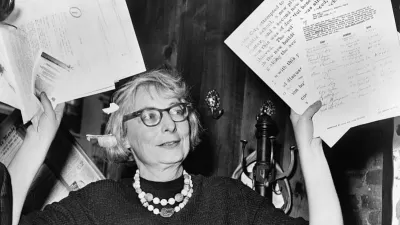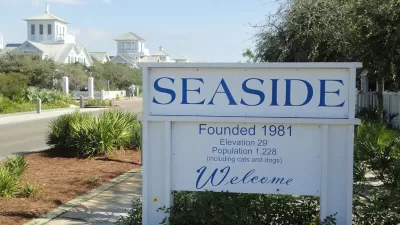Although it is sometimes difficult to recognize in day-to-day planning activities, our ultimate goal is to make the world better, that is, to help create paradise on earth. It’s a tough job, but somebody’s got to do it! There are two different and often conflicting concepts of how to create paradise. It is important that planners understand the differences between them.
Although it is sometimes difficult to recognize in day-to-day planning activities, our ultimate goal is to make the world better, that is, to help create paradise on earth. It's a tough job, but somebody's got to do it!
There are two different and often conflicting concepts of how to create paradise. It is important that planners understand the differences between them.
One concept considers paradise a commodity, a good that consumers purchase based on their ability to pay. For example, magazines often publish articles with titles such as "The Ten Best Places to Live" or "The Ten Best Places To Raise A Family," with the implication that consumers will find happiness simply by living there. Similarly, exotic resorts are promoted as paradise, with the implication that a visit will create a truly orgasmic vacation, and giant regional shopping centers are promoted as shoppers' paradise.
But not everything is a commodity. Many things of great value, such as love, friendship, and health, depend more on people's behavior than their expenditures. From this perspective, paradise is something we create at our current location through responsible and thoughtful effort. Paradise-as-place is reflected in people's efforts to improve their home and garden, befriend their neighbors, and enhance their community's built and natural environments.
These two different visions of paradise often conflict, particularly with regard to transport decisions. Paradise-as-commodity requires ever-increasing mobility so people can chase ever-better real estate and travel deals. Conversely, paradise-as-place often requires limiting mobility, particularly where excessive motorized travel threatens a community's social and environmental quality.
Planning is full of mutually-exclusive decisions that require choosing between enhanced mobility or quality of place. For example, widening a road to allow increased vehicle traffic speeds and volumes increases mobility (and therefore people's ability to live, work and shop in more distant locations) while despoiling the quality of the street environment. Similarly, large parking lots accommodate more vehicle trips to a destination, but degrade the local environment and create a barrier to walking.
Social and personal decisions also involve such tradeoffs. A highly mobile lifestyle allows people to visit more places, reducing people's social networks and emotional investment in any one community. Households located in multi-modal communities (where people rely significantly on walking, cycling and public transit) generally spend less on mobility and more on housing than if they locate in suburban or rural areas, which is economically beneficial since motor vehicles rapidly depreciate while housing investments tend to appreciate, as well as being socially and environmentally beneficial.
Put simply, paradise-as-commodity requires that "mobility trumps place" in planning decisions, while paradise-as-place requires that "place trumps mobility." Unfortunately, many current planning practices inherently favor mobility over place. For example, generous minimum parking requirements in zoning codes, dedicated road and parking facility funds that cannot be shifted to alternative community investments, and consolidation of public services into fewer, larger, more centralized facilities all favor mobility at the expense of existing communities, reflecting the assumption that paradise is a distant place to which people must travel, rather than an enhancement of their current location.
Fortunately, many new trends are returning more balance to mobility-versus-place tradeoffs. Efforts to redevelopment existing communities, apply new urbanism design practices, create streets that are attractive places to be rather than just corridors to travel through, and enhance walkability all reflect a shift toward place-over-mobility.
This is not to suggest that mobility is necessarily bad or that consumers should never travel to exotic locations for holidays. However, it is a warning that we should avoid the temptation to think that the grass is always greener somewhere else, or that increased mobility necessarily makes people happier. This is not a new issue; as Dorothy explained to the good witch Glinda about her adventures in the Land of Oz. "I learned that if I ever go looking for my heart's desire again, I won't look any further than my own backyard, because if it isn't there, I never really lost it in the first place."

Pennsylvania Mall Conversion Bill Passes House
If passed, the bill would promote the adaptive reuse of defunct commercial buildings.

Coming Soon to Ohio: The Largest Agrivoltaic Farm in the US
The ambitious 6,000-acre project will combine an 800-watt solar farm with crop and livestock production.

World's Largest Wildlife Overpass In the Works in Los Angeles County
Caltrans will soon close half of the 101 Freeway in order to continue construction of the Wallis Annenberg Wildlife Crossing near Agoura Hills in Los Angeles County.

California Grid Runs on 100% Renewable Energy for Over 9 Hours
The state’s energy grid was entirely powered by clean energy for some portion of the day on 37 out of the last 45 days.

New Forecasting Tool Aims to Reduce Heat-Related Deaths
Two federal agencies launched a new, easy-to-use, color-coded heat warning system that combines meteorological and medical risk factors.

AI Traffic Management Comes to Dallas-Fort Worth
Several Texas cities are using an AI-powered platform called NoTraffic to help manage traffic signals to increase safety and improve traffic flow.
City of Costa Mesa
Licking County
Barrett Planning Group LLC
HUD's Office of Policy Development and Research
Mpact Transit + Community
HUD's Office of Policy Development and Research
Tufts University, Department of Urban and Environmental Policy & Planning
City of Universal City TX
ULI Northwest Arkansas
Write for Planetizen
Urban Design for Planners 1: Software Tools
This six-course series explores essential urban design concepts using open source software and equips planners with the tools they need to participate fully in the urban design process.
Planning for Universal Design
Learn the tools for implementing Universal Design in planning regulations.



























